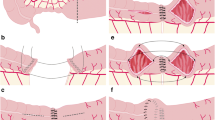Abstract
The charts of 384 patients with Crohn's disease were reviewed to assess the prognostic value of a bowel stenosis documented at the time of initial diagnosis for the occurrence of perforating (abscess, fistula, free perforation) or obstructing complications requiring surgical intervention. Mean follow-up was 5.6 years. At time of diagnosis a bowel stenosis (S) was documented in 143 patients (37.2%). 130 patients underwent surgery, 62 (48%) for obstruction, 18 (14%) for a perforating complication, 12 (9%) for both obstructing and perforating complication and 38 (29%) for intractable disease. The cumulative rates of surgery were calculated using lifetable analysis. The presence of a stenosis at the time of initial diagnosis was a risk factor for the likelihood of surgery overall [65% (S) vs. 40% (no S) after 10 years; P>0.001] and of surgery for obstruction [70% (S) vs. 34% (no S); P>0.001] but did not increase the likelihood of a perforating complication [24% (S) vs. 29% (no S); n.s.]. A perforating complication requiring surgery may therefore not be predicted by the mere diagnosis of a stenosis. Prophylactic surgery of stenotic lesions in patients with Crohn's disease to prevent the development of a perforating complication therefore is not recommended.
Résumé
Les dossiers de 384 malades atteints de maladie de Crohn ont été revus pour évaluer la valeur pronostic d'une sténose intestinale au moment du diagnostic initial pour la survenue d'une complication perforative (abcès, fistule, perforation libre) ou obstructive nécessitant une intervention chirurgicale. Le suivi moyen était de 5,6 ans. Au temps du diagnostic une sténose intestinale (S) était relevée chez 143 patients (37,2%). 130 patients ont subi une chirurgie, 62 (48%) pour obstruction, 18 (14%) pour une complication perforative, 12 (9%) pour une complication à la fois obstructive et perforative et 38 (20%) pour une maladie résistante au traitement. Les taux cumulatifs de chirurgie furent calculés en utilisant une analyse de survie. La présence d'une sténose au moment du diagnostic initial était un facteur de risque avec de probabilité de chirurgie au total de 65% (S) vs. 40% (no S) après 10 ans (P>0.001) et de chirurgie pour obstruction de 70% (S) vs. 34% (no S) (P>0.001) mais n'augmentait pas la probabilité d'une complication perforative (24% S vs. 29% no S; n.s.). Une complication perforative nécessitant la chirurgie peut toutefois ne pas être prévue par le simple diagnostic d'une sténose. La chirurgie prophylactique des lésions sténotiques chez les patients avec une maladie de Crohn pour prévenir le développement d'une complication perforative pour le simple diagnostic de sténose. La chirurgie prophylactique des lésions sténotiques chez les patients avec une maladie de Crohn pour prévenir le developpement d'une complication perforative n'est cependant pas recommandée.
Similar content being viewed by others
References
Farmer RG, Hawk WA, Turnbull RB (1976) Indications for surgery in Crohn's disease. Gastroenterology 71:245–251
Greenstein AJ, Lachman P, Sachar DB, Springhorn J, Heimann T, Janowitz HD, Aufses AH (1988) Perforating and non-perforating indications for repeated operations in Crohn's disease. Evidence for two clinical forms. Gut 29:588–595
Binder V, Hendriksen C, Kreiner S (1985) Prognosis in Crohn's disease-based on results from a regional patient group from the county of Copenhagen. Gut 26:146–150
Harper PH, Fazio VW, Lavery IC, Jagelman DG, Weakley FL, Farmer RG, Easley KA (1987) The long-term outcome in Crohn's disease. Dis Colon Rectum 30:174–179
Fasth S, Helleberg R, Hultén L, Magnusson O (1980) Early complications after surgical treatment for Crohn's disease with particular reference to factors affecting their development. Acta Chir Scand 146:519–526
Post S, Betzler M, von Ditfurth B, Schürmann G, Küppers P, Herfarth C (1991) Risks of intestinal anastomoses in Crohn's disease. Ann Surg 213:37–42
Tonelli F, Ficari F (1991) Pathological features of Crohn's disease determining perforation. J Clin Gastroenterol 13:226–230
Malchow H, Ewe K, Brandes JW, Goebell H, Ehms H, Sommer H, Jesdinsky H (1984) European Cooperative Crohn's Disease Study (ECCDS). Results of drug treatment. Gastroenterology 86:249–258
Farmer RG, Whelan G, Fazio VW (1985) Long-term follow-up of patients with Crohn's disease. Clinical pattern-prognosis. Gastroenterology 88:1818–1825
Prantera C, Levenstein S, Capocaccia R, Mariotti S, Luzi C, Cosentino R, Simi M (1987) Prediction of surgery for obstruction in Crohn's ileitis. A study of 64 patients. Dig Dis Sci 12:1363–1369
Author information
Authors and Affiliations
Rights and permissions
About this article
Cite this article
Makowiec, F., Jehle, E.C., Köveker, G. et al. Intestinal stenosis and perforating complications in Crohn's disease. Int J Colorect Dis 8, 197–200 (1993). https://doi.org/10.1007/BF00290305
Received:
Accepted:
Issue Date:
DOI: https://doi.org/10.1007/BF00290305




